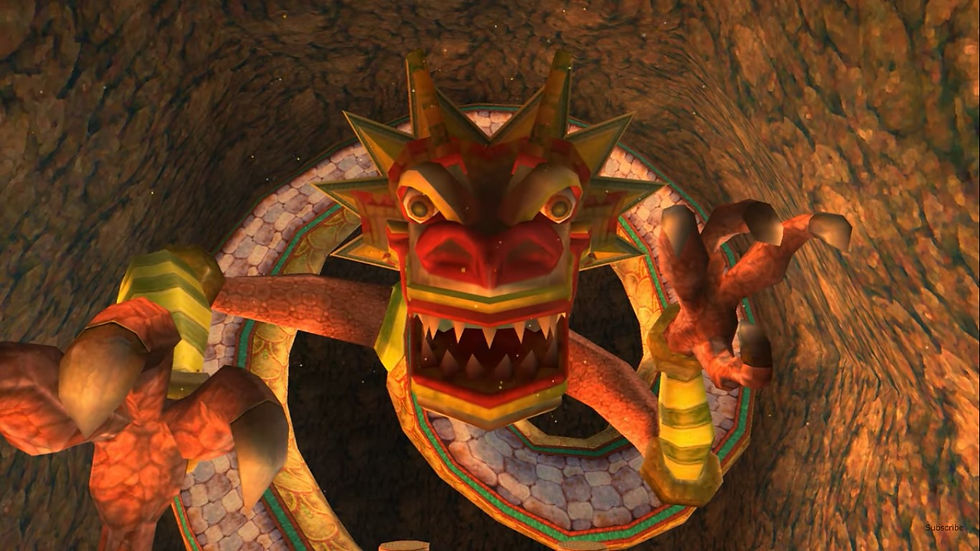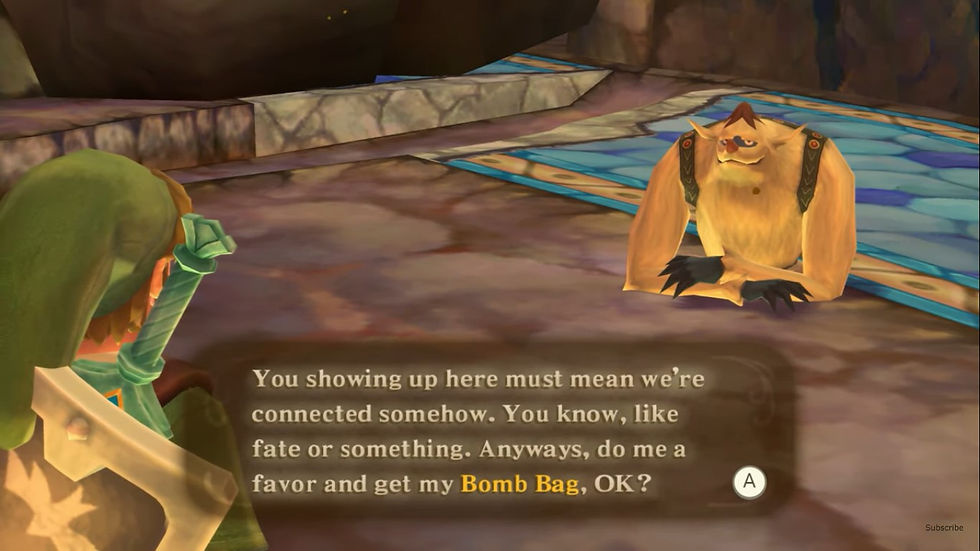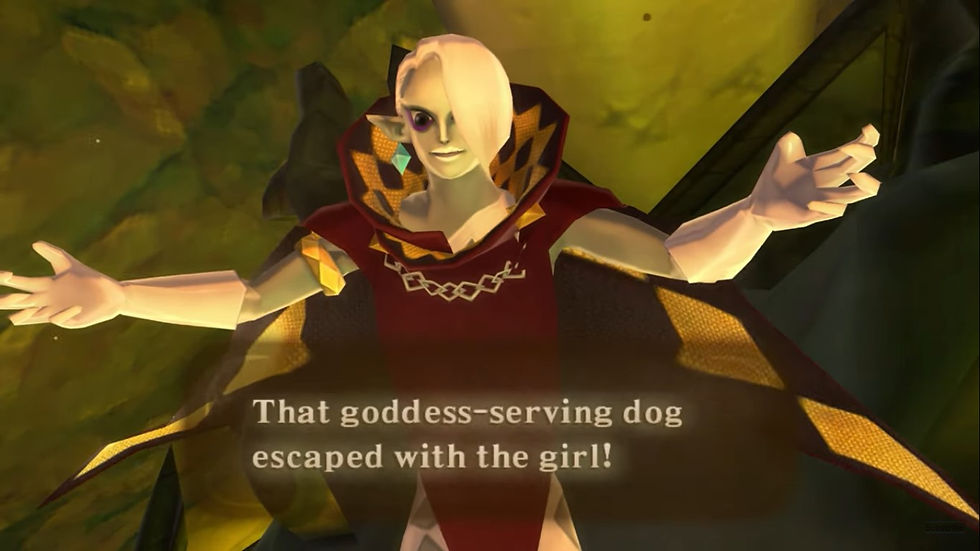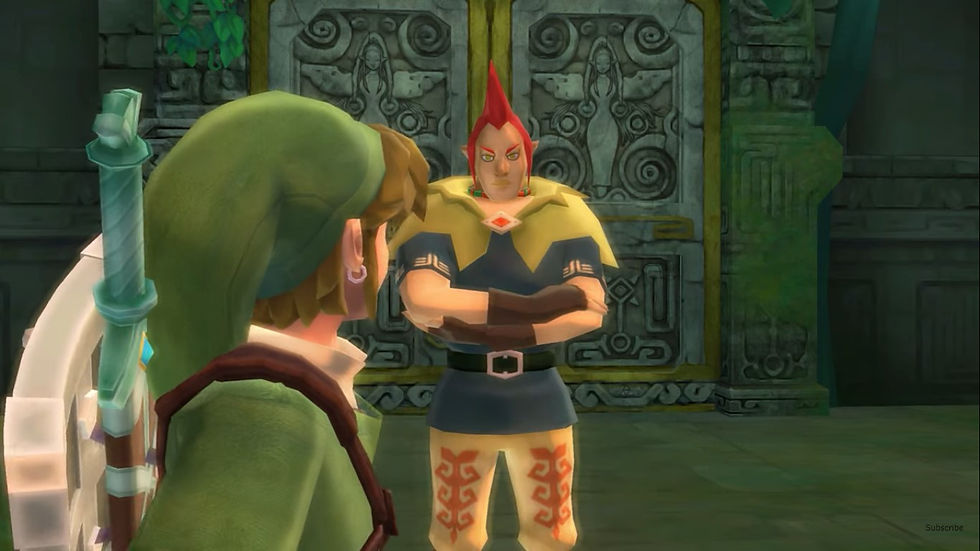Field Note #6: Indiana Link and the Temple of Earth
- The Wolfess

- Jun 17, 2020
- 7 min read

Base Stats:
Game: Skyward Sword
Version: Original Wii Version, Physical Copy
System: Nintendo Wii U
Session Play Time: 1 hr 45 min
Total Play Time: 10 hrs 24 mins
Content Covered: The Earth Temple and placing the Amber Tablet
Fi Report: 5 Forced Interruptions
If you have ever watched Indiana Jones and the Temple of Doom you will have a great sense for what playing through the Earth Temple feels like. There is fire and lava and statues of strange gods all over the place. There are also a multitude of mechanical traps and puzzles that the hero—whether we are talking about Link or Indiana Jones—must overcome in order to obtain the treasure in the temple. It is a roaringly fun adventure from start to finish, and it’s one of my favorite temples in a game whose dungeons are easily one of its biggest strengths.
This is largely due to a few intriguing design elements: first, the dungeon is distinctly an earth temple, not a fire temple. This is evidenced by the fact that most of its puzzles, although involving lava pits or fire features, actually focus on various earth-based elements like large rock boulders (both functioning as tools and obstacles), rock platforms that allow you to traverse lava, cracked rock walls that give you access to hidden areas, and even a rock-encased final boss.

Second, it features two lovable mogma friends—Ledd and his best bud Cobal—who get in way over their heads by entering the temple in search of treasure and getting separated from one another. They don’t play a huge role in the temple, but they are repeated characters through several sections of the game (this being their third appearance) and I find them pleasantly amusing. It’s intriguing to note that Ledd is the first character in the game to tell Link that they must be connected by fate. Sure, other characters speak of fate and destiny, but Ledd the Mogma is the first character to talk about the connection—something which will come up again. I’m sure we will discuss it more then.

The third element that makes the Earth Temple so fun is the adventurous, Indiana-Jones-like mechanical puzzles. First, it’s cutting rope in order to drop an old bridge. Then it’s throwing something at a bomb in order to dislodge the eyeball of a grotesque statue so you can balance atop that stone eyeball to traverse the lava. The eye becomes a main weapon (and mode of transportation) throughout the first section of the temple. What about running up a steep grade while rocks drop from iron traps in the ceiling to try to crush Link? Link must duck into a crevasse on the slope at just the right time in order to survive. Or the best of the traps by far—after Link retrieves the golden dragon statue from the master key chest, a giant bolder appears out of the dragon’s mouth and tries to crush him. Link runs for his life down the narrow pathway (suspended over a pit of lava of course) and then ditches into the stairs to his left at the last possible second. It’s adrenaline-inducing, heart-pounding fun and there’s no temple like it elsewhere in Zelda.

With your heart still pounding from excitement, you use the statue to unlock the boss door (seriously, we’re in an Indiana Jones movie, right??), and what greets us in the room beyond? Chains on the ground, which Fi informs you once held Zelda, and an eerie silence. As Link moves up the slope, we encounter our favorite flamboyant Demon Lord, Ghirahim, who expresses anger and despair over losing the “spirit maiden” Zelda to “that Goddess-Serving Dog” Impa again. Again? As far as Link knows, this is the first time. Those who have played the game will probably know when the first time was, but I won’t spoil it in this article for those who haven’t played it.

But where this part of the game really shines is when the fight with the lava-monster inside that boulder from earlier is over. When Link enters the Earth Spring, triumphant and covered in a sweat that would make Harrison Ford proud I’m sure, he finally sees Zelda alive and well. It’s in that moment of victory and excitement when the “goddess-serving dog” stops their reunion short, sends Zelda on her way, and reprimand’s Link for his failure. In Impa’s own words:
“It took you far to long to get here. Looking at you, I fear the goddess is mistaken in her choice of agents. If this failure is any indication, you have no hope of defending Her Grace from those who seek to assail her. Do my words anger you? Do my words sting? Let them. If I had not come when I did, your Zelda would already have fallen into the hands of the enemy. The truth of it is you were late. You were late and you failed to protect her.”
I can’t think of another time when Link is flat out told that he, personally, failed. Sure, he’s been called foolish before, but he’s never been told that he outright failed (not counting Breath of the Wild, which wasn’t released yet, and some might argue that was more Zelda’s failure than Link’s). It especially feels like a slap in the face on the tail end of our success in traversing the Earth Temple’s many traps and our victory against Ghirahim’s lacky. We’re the chosen hero, right? Living out our destiny, doing our saving the world thing, killing monsters and saving people as knights do (see Field Note 4), and she’s telling us that we failed? That we were slow?
It does sting—for both the player and for Link himself. He casts his eyes down in shame and anger. For the first time, you see Link’s green-clad shoulders tremble a bit. He was reprimanded like the sleepy skyloftian child that he still is. As we discussed in the first field note (see Field Note 1), this Link has had everything handed to him on a silver platter. He was given every advantage. Now he’s on his own, doing his own thing for the first time with no one to help him, and he failed at it. Impa literally closes out the conversation by telling him exactly what he needs to do before he will be allowed to see Zelda and saying “am I understood?” like a disappointed mother reprimanding a misbehaving child. Ouch.
This tense dynamic between Impa and Link is fascinating and continues through several encounters with her, but it’s no more on the surface than now. The truth is that they both want what’s best for Zelda. Their opinions about the best method and location for her safekeeping are very different, however, as are their abilities to guard her. Impa thinks that the best way to keep Zelda safe is to be with her at every moment and to help Zelda discover her own inner power. Link, however, thinks that it would be best to take Zelda back to Skyloft where she would be separate from the danger and everyone in the knight academy could guard her. Unfortunately, Link himself can’t stick around to be with her all the time in such a scenario—he must defeat the evil in the temples and save the world. To do that, he can’t be with Zelda.

Let me talk a little bit more about Impa. Bear with me for a moment—this is going somewhere relevant, I promise. Fun fact: Impa is in 9 of the 20 mainline Zelda games (including her incarnation in Twilight Princess, “Impaz”). Ganondorf, the human incarnation of Ganon, is only in 4 games. Even Ganon himself, the very face of evil in Zelda, is found in just 14 of those 20 games—just 5 more games than Impa, and a couple of those are practically cameo appearances. Sure, other look-alike characters exist throughout the Zelda series, but none appear as many times or play as much of a pivotal role in the cycle of destiny itself than Impa does. Isn’t that strange?
In an interview in Hyrule Historia, Shigeru Miyamoto says this about Impa:
“The old female storyteller who feeds information to Zelda is named Impa; her name comes from the word Impart. Impa, Link, and Zelda were the guardians of the Triforce. Today, when you think of characters who are connected to the Triforce, you think of Link, Zelda, and Ganon, but that started in Ocarina of Time. Originally, Ganon was only a villain in relentless pursuit of the Triforce.”
Hold the phone—did the creator of the entire series just say the three people connected to the Triforce as guardians were originally Link, Zelda, and Impa? Could it be that this seemingly random woman who just happens to always show up to guide the mortal goddess and her chosen hero has more significance in the Cycle than we are led to believe? Is she a chosen agent sent by Hylia to ensure the defeat of Demise’s incarnation? I think that this is true, and that there is an explanation for it in Skyward Sword itself.
We know that Link and Zelda continually reincarnate because of Demise’s Curse—those who possess the blood of the goddess and the spirit of the hero. In Skyward Sword, Impa says that she is a member of the Sheikah, “the goddess’s chosen guardians”, and that the goddess Hylia commanded her to go through the gate of time to protect Zelda and help in the fight against Demise. Hylia chose Link to save the world, yes—but she also chose Impa to save herself and to guide the hero. As Zelda later tells Link, the goddess used their bond as a motivational tool. He was never meant to guard her. That was not his destiny. It was Impa’s. I believe that it is still Impa’s destiny all these years later. She still reincarnates to protect the princess and guide the hero to his true destiny, as she does here (although she’s a little gentler about it in the future).

However, I might be getting ahead of myself and away from the scene at hand. This theory pulls on lore from later in the game which we can discuss more in depth then. For now, I will leave us with this: this section of gameplay brought us a swashbuckling Indiana Jones adventure that was fun from start to finish. However, it also brought us a sobering moment in which Link hits his lowest point, psychologically. In a literary theory we’ve referenced before, The Hero’s Journey, this is called the “supreme ordeal” or “the belly of the whale”—it is a point at which the hero’s greatest fears are realized, and they are forced to grow—to be reborn—in order to succeed. I would say that Impa’s declaration of failure here is that point for Sky. After this point, we begin to see a change in him. He starts growing up and taking responsibility for himself. This scene is pivotal in his story, and I look forward to seeing how these changes begin to take place.
What do you think about Link’s exciting adventure in the Earth Temple? Do you agree that Impa has a more important role to play in the cycle than we’re initially led to believe? Let me know in the comments below, and I look forward to seeing you in the next Field Note.




Commentaires